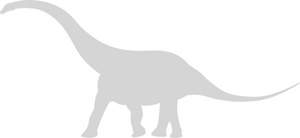Every month, 100,000 readers use the Dinosaur Database, but we receive no support from you. Developing and updating the database requires a lot of work. If you want it to remain open and be updated, please support us via the "Buy us a coffee" button available on every page or via the Support page.
Dinosaur: Ardetosaurus viator

| Length*: | 19.4 m | 63.6 ft |
| Weight*: | 6 t | 13,228 lb |
*The largest known specimen
Period
Epoch: Late Jurassic
Stage: Late Kimmeridgian
Years: 150.4–149.2 Ma
Details
Status: valid
Author: Tom T.P. van der Linden et al.
Year: 2024
Distribution
Area: North America
Country: USA
Region: Wyoming
Formation: Morrison
Description
Ardetosaurus viator
Ardetosaurus viator is a newly described species of diplodocine sauropod from the Morrison Formation, dating back to the Late Jurassic (150.4–149.2 million years ago). Discovered in the Howe-Stephens Quarry in northern Wyoming, this species contributes to the diversity of diplodocines in this iconic fossil-rich formation. Its genus name, Ardetosaurus, references the damage caused by a museum fire that impacted the specimen, while viator means “traveler,” alluding to the fossil’s journey across different locations.
Physical Characteristics
The holotype specimen (MAB011899) is a partial, articulated skeleton, including vertebrae from the neck, back, and tail, as well as part of the pelvis and hind limbs. Notable anatomical traits include paired accessory laminae in the vertebrae, which differentiate Ardetosaurus from other diplodocines like Diplodocus and Galeamopus. Its femur is estimated to be 1.3 meters (4.3 feet) long, and the tibia measures around 91.5 centimeters (36 inches). These measurements suggest a total body length of roughly 18–20 meters (59–65 feet).
Diet and Feeding Habits
Like other members of the Diplodocinae, Ardetosaurus viator was a herbivore, feeding on low-growing vegetation and coniferous plants. Its long neck would have allowed it to reach plant material from different levels, enabling it to efficiently browse large areas. Its peg-like teeth, characteristic of diplodocines, were likely adapted for stripping leaves from branches, and its large, barrel-shaped body housed a complex digestive system to process fibrous plant material.
Habitat and Distribution
Ardetosaurus viator lived in the semi-arid environments of the Morrison Formation, which spanned parts of present-day western North America, including Wyoming, Utah, and Colorado. The Morrison Formation, where Ardetosaurus was discovered, was a semi-arid environment characterized by floodplains, rivers, and seasonal wetlands. During the Late Jurassic, this area supported a rich variety of dinosaur species, including other sauropods, theropods, and smaller herbivores. The Howe-Stephens Quarry is notable for producing a range of sauropod fossils, including Diplodocus, Camarasaurus, and Apatosaurus.
Behavior and Social Structure
Given its size and the evidence from other diplodocines, Ardetosaurus viator likely lived in herds, which would have provided protection from predators and facilitated social interaction. The long neck and whip-like tail of Ardetosaurus suggest it could forage across wide areas without needing to move extensively, conserving energy. Herding behavior may also have helped it find food more efficiently in the semi-arid environment of the Morrison Formation.
Discovery and Research
The holotype specimen (MAB011899) of Ardetosaurus viator was excavated between 1993 and 1994 from the Howe-Stephens Quarry in Wyoming. The specimen, nicknamed “Brösmeli,” was initially sent to Europe for preparation but suffered damage in a 2003 fire. The discovery of vertebrae and limb bones, coupled with morphological analysis, led paleontologists to recognize it as a new genus and species of diplodocine in 2024. Comparative studies with other diplodocines, such as Diplodocus and Barosaurus, revealed key anatomical differences that warranted the designation of a new genus. The specimen’s excellent preservation allowed for detailed study of its vertebral anatomy, which played a crucial role in the classification process. Despite the destruction of some bones, the specimen was later transferred to the Netherlands’ Oertijdmuseum, where it was studied and formally described as a new genus and species in 2024.
Significance and Interesting Facts
The discovery of Ardetosaurus viator is significant because it expands the known diversity of diplodocine sauropods in the Morrison Formation, a region already famous for its rich sauropod fauna. Its unique vertebral and femoral morphology offers new insights into the evolution and specialization of diplodocines during the Late Jurassic. One interesting fact about Ardetosaurus is that it may have been more agile than other diplodocines due to its distinctive skeletal features, suggesting potential differences in movement or habitat use.
Locations
Sources
Material: Two posterior cervical vertebrae (CV), which very likely represent cervical vertebrae 13 and 14, 10 dorsal vertebrae (DV), which very likely represent DV1-DV10, multiple thoracic ribs, a partial sacrum including a left ilium, five anterior-most caudal vertebrae, two anterior chevrons, a left coracoid, both pubes and ischia, an incomplete left femur, a left tibia, and a partial left fibula
References: A new diplodocine sauropod from the Morrison Formation, Wyoming, USA Tom T.P. van der Linden, Emanuel Tschopp, Roland B. Sookias, Jonathan J.W. Wallaard, Femke M. Holwerda, and Anne S. Schulp



